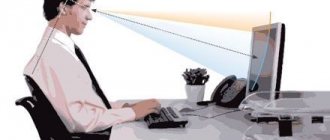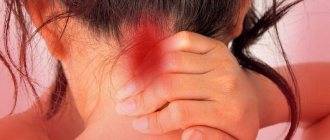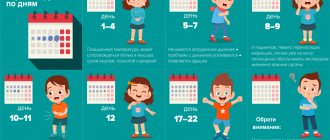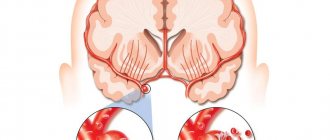Constant headaches are a common reason for patients to turn to neurologists at the Yusupov Hospital. People experience headaches in the evening, in the morning after sleep, which do not go away after taking painkillers, and at night. Frequent headaches in men can occur in the presence of pathology of cerebral vessels or brain tumors.
Persistent headache is an indication for a comprehensive examination of the patient. Neurologists conduct instrumental analyzes using the latest equipment from leading global manufacturers. Analyzes are performed by experienced laboratory technicians. Patients are advised by candidates and doctors of medical sciences. Leading specialists in the field of headache treatment collectively develop tactics for managing patients whose headache does not go away for several days.
Causes
A headache does not always mean the presence of a disease.
It can also occur as a response to negative environmental factors (lack of oxygen, stuffiness, smoke), due to long hours of work, hunger, hangover or lack of sleep. However, this symptom should not be ignored, because headaches can also be the result of a variety of diseases of the brain, nervous system and internal organs.
Viral gastroenteritis
Any inflammatory process in the body causes headaches, including infectious lesions of the stomach and small intestine - viral gastroenteritis. Rotavirus is the cause of 40% of cases of acute intestinal infections in children under 14 years of age and 55-60% in children under 5 years of age.
Inflammation begins after various viruses enter the gastric mucosa:
- rotaviruses - one of the main causative agents of gastroenteritis;
- caliciviruses - released into the external environment along with the feces of an infected person;
- intestinal adenoviruses, especially dangerous for young children;
- astroviruses, transmitted mainly by contact.
The main symptoms of acute viral gastroenteritis:
- diarrhea,
- nausea and vomiting,
- headache,
- general weakness,
- tachycardia.
As the disease progresses to the chronic stage, periodic headaches persist and stomach pain appears after eating. Diagnosis is based on taking a medical history and identifying the pathogen.
Brain aneurysm
A pathological protrusion of the walls of blood vessels supplying the brain is called an aneurysm. The danger of the disease is that a person may not suspect a “time bomb” in his own head for a long time and only learn about it when a blood vessel ruptures. Very often, an aneurysm is diagnosed during a routine medical examination.
Thinning and stretching of the vessel wall can lead to hemorrhagic stroke - bleeding in the brain. Risk factors for developing an aneurysm include heredity, trauma, cardiovascular disease, and bad habits (Fig. 1).
Figure 1. Factors that increase the risk of aneurysm. Source: MedPortal
The headache caused by an aneurysm is caused by the pressure of the blood-filled sac-like bulge on the nerves and surrounding tissue. Attacks of pain are similar to migraines and most often affect the back of the head.
Stroke
A stroke is a vascular accident that damages parts of the brain. Acute cerebrovascular accident occurs either due to a decrease in the lumen of the cerebral arteries (cerebral infarction or ischemic stroke) or due to rupture of a vessel and hemorrhage in the brain (hemorrhagic stroke).
A sharp headache is characteristic of a hemorrhagic stroke. The rupture of a vessel and blood pressure on the nerve endings of the meninges cause severe suffering to a person. Pain during a stroke has different localization, affecting the back of the head, the forehead or the entire head (Fig. 2).
Figure 2. Symptoms of a stroke. Source: MedPortal
Pain during an ischemic stroke may be absent or mild.
Important! At the first sign of a stroke, you should immediately call an ambulance! Doctors may have only 4.5 hours to save a patient.
Brain tumor
Neoplasms in the brain, regardless of etiology, always cause headaches. This is due to the fact that as the tumor grows, it begins to put pressure on the nerve endings located inside the skull and affects the meninges and blood vessels. Pain is also caused by increased intracranial pressure due to an enlarging tumor.
The intensity of pain depends on the size of the tumor and its location. In the initial stage of the disease, a person does not feel any discomfort and does not consult a doctor. When symptoms become severe, the tumor is often quite large and affects large areas of the brain.
If the neoplasm affects peripheral vessels, painful attacks are migraine-like. Sometimes the pain syndrome is accompanied by nausea, clouding of consciousness, and convulsive seizures.
Hypertonic disease
People suffering from high blood pressure often complain of headaches in the back of the head. The pain may be throbbing, pressing or aching.
Pain in hypertension is due to the fact that when blood vessels lose elasticity, the blood flow puts pressure on the vascular nerve endings. This pain is typical for older people who have suffered from hypertension for a long time.
At a younger age, a person may not experience any unpleasant symptoms of high blood pressure and learn about the problem only during a routine medical examination.
Increased intracranial pressure
Intracranial hypertension is a neurological diagnosis associated with impaired circulation of cerebrospinal fluid. The causes of high blood pressure are most often associated with the presence of other diseases or due to reasons not directly related to the brain:
- the use of vasoconstrictors, antibacterial, hormonal and some other groups of drugs;
- vascular atherosclerosis, hematomas, blood clots and other obstacles to the cerebrospinal fluid;
- stroke, encephalitis and other disorders of the nervous system;
- renal pathologies;
- brain tumors and hematomas;
- toxic lesions;
- problems with the endocrine system;
- congenital pathologies, for example, hydrocephalus.
Headache is the main symptom of increased intracranial pressure, but a comprehensive examination is required to determine the causes of the pathology.
Cervical osteochondrosis
Cervical osteochondrosis and the pain associated with it are our retribution for long hours spent at the computer and reluctance to walk. Causes of degenerative-dystrophic lesions of intervertebral discs and muscle spasms:
- overweight and obesity,
- poor nutrition,
- stress and emotional stress,
- excessive zeal in the gym and incorrect technique for performing strength exercises,
- sedentary work.
All of them are directly related to the wrong lifestyle. Damage to the cervical vertebrae and intervertebral discs can also be a consequence of trauma and congenital abnormalities of the spine.
Without proper treatment, osteochondrosis can be accompanied by increasing pain in the head and back, poor circulation and the formation of a hernia.
Neck myogelosis
Very severe headaches occur with myogelosis - thickening of the muscles in the neck, although painful nodules can also appear in other parts of the spine. Seals occur due to changes in the structure of muscle protein; they are easily palpated.
The main causes of myogelosis:
- sedentary work, sedentary lifestyle,
- hypothermia and drafts,
- nervous tension causing muscle spasms,
- scoliosis.
Myogelosis can develop against the background of cervical osteochondrosis, herniated intervertebral discs and inflammatory processes in the musculoskeletal system. Risk factors also include arterial hypertension, injuries and sprains, and professional sports.
Myogelosis headache torments a person with any turn of the head or change in body position. The disease is difficult to diagnose because its symptoms are similar to many other spinal pathologies.
Diagnostics
Neurologists at the Yusupov Hospital conduct a comprehensive examination of patients. It allows you to determine the exact cause of the headache. Patients are prescribed the following studies:
- Computer and magnetic resonance imaging of the brain;
- Ultrasound Doppler examination of the vessels of the head and neck;
- Electroencephalography;
- Echoencephalography;
- REO-encephalography.
The doctor recommends that the patient keep a headache diary in which he needs to record the following information:
- When did the pain occur?
- What is its intensity;
- How long did the attack last?
- Has your blood pressure risen?
The patient brings the diary to an appointment with a neurologist. The doctor analyzes the information provided by the patient, the results of the studies performed and develops tactics for managing the patient.
Other reasons
Headache can be caused by other reasons:
- hormonal changes in the body during pregnancy, with the onset of menopause,
- some diseases of the endocrine system - hyperthyroidism, diabetes mellitus, dysfunction of the adrenal glands;
- acute respiratory diseases;
- sinusitis, otitis, sinusitis, tonsillitis;
- traumatic brain injury, concussion;
- infectious lesions;
- chronic inflammatory processes in the body.
Headache, pills and chewing gum
Sometimes a headache can occur due to a completely unexpected reason. For example, headaches that occur while taking certain painkillers are called headaches.
An interesting study was conducted by Israeli scientists. They found that young people and teenagers who constantly chew gum often experience headaches. This is due to tension in the temporomandibular system due to continuous load during chewing movements.
Such a variety of causes of headache requires special attention to the nature of the sensations, the localization of the source of pain, and its intensity. A symptom checker can sometimes reveal more about the source of the problem.
However, only a thorough history taking and a comprehensive examination will help establish the correct diagnosis and determine treatment tactics.
Sinus pain
Signs. Sinus pain is caused by inflammation of the area around the nose, inflammation in the sinuses. It is characterized by pressing, throbbing pain around the nose, under the eyes, and in the forehead. When bending or turning the head, the pain may intensify. The nose is stuffy and can't breathe. Fatigue and swelling of the mucous membranes of the sinuses and nasal cavity appear. The head may hurt until the underlying disease is cured.
Causes. Inflammatory process of the sinuses. Due to nasal congestion, there is a lack of oxygen in the brain, hence fatigue. Such pain can be complicated after a cold or allergy.
Treatment. The disease can be eliminated by taking antibiotics; for allergens, antihistamines should be taken and the cause of the allergy should be eliminated. You need to see a doctor.
Classification
In modern clinical practice, the classification developed by the classification committee of the International Headache Society is used. In accordance with it, headaches are divided into primary, secondary and neuralgia.
Primary pain
The main pain of this type is migraine. It is not associated with any pathologies of internal organs, systemic diseases or injuries. Primary headaches also include:
- tension is the most common type of pain,
- after physical stress, sex, emotional stress,
- during long flights, climate change, sudden changes in weather,
- cluster.
The cause of primary pain is the chemical activity of brain cells and blood vessels and the increased sensitivity of pain receptors.
Secondary pain
Secondary pain is always associated with an existing disease. They may be a symptom:
- osteochondrosis,
- colds or viral diseases,
- hypertension,
- brain tumors,
- traumatic brain injuries and many other pathologies.
Neuralgia
Neuralgia is a condition caused by damage to the peripheral nerves. Severe headaches occur with inflammation of the trigeminal, glossopharyngeal, and occipital nerves. Neuralgia can be of a different nature and vary in intensity, appear suddenly or gradually increase.
Inflammation of the nerves can occur due to stress, hypothermia, problems with the immune system, or prolonged fasting.
In the occipital region of the head
In the back of the head, cephalgia occurs when blood pressure increases, the cause of which is osteochondrosis, spondylosis, spondylolisthesis, anomalies in the development of blood vessels in the head or neck.
Severe pain in the back of the head occurs after nervous strain, as a result of spasm of the neck muscles, arteries of the head and neck, and disruption of the outflow of venous blood from the head. It worries patients suffering from occipital neuralgia, vertebrobasilar insufficiency, spinal diseases, and migraines. A sharp headache in the back of the head often occurs with the development of a hypertensive crisis. Sharp, bursting, pulsating headaches in the back of the head are accompanied by pallor of the patient’s face, generalized hyperhidrosis, dry mouth, heart pain and tachycardia.
Chronic arterial hypertension with a slight increase in blood pressure is also characterized by the development of pain mainly in the occipital part of the head. The headache bothers the patient immediately after waking up, intensifies with physical activity, and is often accompanied by swelling of the lower eyelids. Pain is caused by a violation of the outflow of venous blood from the vessels of the head.
Different types of headaches
Doctors identify more than 250 types of headaches, but some of them are more common than others (Fig. 3).
Figure 3. Common types of headaches. Source: MedPortal
Tension
Tension or tension headaches are the responsibility of a neurologist. This is the most common and varied type of pain. It can cover just one area, such as the forehead or back of the head, or spread over the entire head (Fig. 4).
Figure 4. Tension headache. Source: MedPortal
According to subjective sensations, tension pain resembles compression of the skull and muscle tension. People who spend a lot of time at the computer, lead a sedentary lifestyle, truck drivers, seamstresses, and office workers are most prone to tension pain.
You can get rid of periodic tension pains by changing your lifestyle and including mandatory walks in the fresh air and gymnastics in your daily routine. You should also avoid stressful situations and excessive physical activity if possible.
Post-traumatic
Pain can appear not only after a head blow, but also after any spinal injury, and not immediately after it, but after several weeks or months.
Special treatment for such headaches is not required; the condition can improve after general restorative procedures prescribed to eliminate the consequences of injury: gymnastics, massage, normalization of sleep and diet.
Migraine
Migraine is one of the most intense headaches, usually affecting half of the skull (Fig. 5). An attack can be triggered by certain foods, stress, an irritant in the form of an unpleasant or simply concentrated odor, or a bright flashing light.
Figure 5. Pattern of pain in migraine. Source: MedPortal
Migraine is often accompanied by nausea, dizziness, and general weakness. It mainly affects middle-aged women. There is no single method of treating migraines, but your doctor will help you choose medications that relieve unpleasant symptoms.
Migraine aura
About 25% of people suffering from migraines see black dots or bright lines in front of their eyes, hear extraneous noises, or smell an intrusive odor before attacks of pain. It's all an aura, and it usually ends when the pain begins. Another possible companion to migraine is Alice in Wonderland syndrome, when a person is unable to adequately perceive his own size in space.
Sinus
Most often, such pain is associated with inflammation of the nasal sinuses, so they are localized in the area of the bridge of the nose or forehead (Fig. 6). The pain is very severe and occurs against a background of difficulty breathing, nasal congestion, fever, and swelling. Antihistamines (if the cause of nasal congestion is an allergy) or antibiotics prescribed by a doctor can help get rid of such pain.
Figure 6. Characteristics of sinus headaches. Source: MedPortal
Cluster
Such intense acute pains are mainly characteristic of men and are difficult to treat. The attacks can be short-lived, but sometimes last a day or more. The pain is pulsating in nature, usually localized in the eye area, accompanied by swelling of the nasal mucosa and lacrimation.
Infectious
Almost all infectious diseases are accompanied by headaches of varying nature and intensity. The pain goes away after successful treatment of the underlying pathology.
Hypertensive
An increase in blood pressure is often accompanied by a nagging pain in the occipital region. This is especially true for older people. After taking antihypertensive drugs and normalizing the condition, the pain goes away, however, it can appear with a sharp decrease in pressure.
Hormonal
Headache due to changes in hormonal levels is familiar to most women before the onset of menstruation. Similar pain occurs in women in the early stages of pregnancy and during menopause. Most often, discomfort is felt in the upper part of the head and temples. Menopausal pain can be relieved by selecting compensatory therapy from a specialist.
Tumor
As the tumor grows in the brain, the pain intensifies. Usually the attack begins in the morning and is accompanied by nausea and dizziness. The symptoms in this case are relieved with painkillers, the pain goes away after defeating the tumor.
Caused by intracranial bleeding
When a vessel ruptures, pain appears suddenly and is usually accompanied by vision problems, slurred speech, and loss of orientation. Such symptoms require urgent medical attention.
Related to trigeminal nerve injury
The trigeminal nerve hurts in sharp, pulsating short attacks, the pain covers the entire head or only the face area. Anticonvulsants and physiotherapeutic procedures are prescribed to relieve pain.
Cervicogenic headache
The pain is associated with problems in the cervical spine and is usually localized only on one side. Pain can occur when you move your head suddenly or when you change body position. Complex therapy includes muscle relaxants, nonsteroidal anti-inflammatory drugs, and anticonvulsants.
Cluster pain
Signs. This type of pain, although rare, is very severe and most often affects middle-aged men. Severe throbbing pains appear at night, one side of the head hurts in the eye area. The pain continues for an hour; in severe cases, attacks can be repeated several times a day. Accompanied by redness in the eyes, the appearance of tears, and a reaction to bright light.
Causes. The causes of cluster pain have not been studied, but many scientists associate them with a disruption of human biological rhythms. Treatment. The pain will subside only after taking a strong painkiller. You must go to a medical facility and undergo an examination.
Brain tumor
Hypochondriacs and simply worried patients often link headaches to brain cancer. We hasten to reassure you: in fact, only 4% of tumor formations manifest themselves in this way.
Signs . If the pain is still associated with a tumor, it usually appears in the morning and is accompanied by vomiting. The episodes are repeated periodically and become worse and worse over time. If this background is accompanied by sudden weight loss, personality changes and seizures, this is a reason to undergo a brain examination.
Possible reasons . When the tumor grows to a certain size, the increase in brain volume leads to increased intracranial pressure. Hence the initial symptoms.
How to treat . Depends on the location, size and type of formation.
Migraine
Signs . Migraine refers to recurring pain on one side of the head that lasts about 4 hours or longer. Migraine episodes tend to be recurring and can lead to dizziness, nausea, and photophobia (photophobia). Sometimes, before the onset of an attack, patients experience visual abnormalities - they see bright colored rings and stripes - or feel a slight tingling sensation throughout the body.
Possible reasons . The mechanism by which migraines occur has long been the subject of debate in scientific circles. Now doctors are sure that this is definitely not a mental illness. It is associated with a dysfunction of the brain, but what kind is not known for certain. It has been noted that during the process of pain, the blood vessels of the head greatly expand, and abnormal electrical activity occurs in the cerebral cortex.
How to treat . In approximately 20% of people suffering from migraines, pain occurs after a certain external influence - a strong smell, a loud monotonous sound, cigarette smoke, etc. Doctors simply advise such patients to avoid “risk factors”, while the rest can only take medications as prescribed (the most effective ones are triptans, but they act almost like a drug - the more you drink, the worse the treatment). Unfortunately, it is impossible to completely cure migraines, and simple painkillers will hardly help the case.









